Continuous Tracking of Forest Disturbance and Recovery in the Greater Khingan Mountains from Annual Landsat Imagery
Abstract
:1. Introduction
2. Materials and Methods
2.1. Study Area
2.2. Basic Data
2.3. Integrated Detection of Forest Disturbance and Recovery
2.3.1. Processing of Annual Landsat Imagery
2.3.2. LandTrendr Algorithm and Parameter Settings
2.3.3. RF Classifier and Implementation
2.3.4. Year Assignment and Accuracy Assessment
2.4. Spatial Analysis of Forest Disturbance and Recovery Based on Multiple Factors
3. Results
3.1. Accuracy Assessment
3.2. Historical Reconstruction of Forest Disturbance and Recovery
3.3. Spatial Characteristics of Forest Disturbance and Recovery
3.3.1. Forest Disturbance and Recovery Distribution across Varying Levels of Burn Severity
3.3.2. Spatial Variations in Forest Disturbance and Recovery across Distinct Topographic and Geographic Conditions
4. Discussion
4.1. Advantages and Reliability of the Proposed Approach
4.2. Spatio-Temporal Patterns of Forest Disturbance and Recovery
4.3. Forestry Policies and Forest Changes
4.4. Implications in Forest Monitoring and Its Protection
5. Conclusions
Author Contributions
Funding
Data Availability Statement
Acknowledgments
Conflicts of Interest
References
- Gauthier, S.; Bernier, P.; Kuuluvainen, T.; Shvidenko, A.Z.; Schepaschenko, D.G. Boreal forest health and global change. Science 2015, 349, 819–822. [Google Scholar] [CrossRef]
- Li, Y.; Xu, X.; Wu, Z.; Fan, H.; Tong, X.; Liu, J. A forest type-specific threshold method for improving forest disturbance and agent attribution mapping. GI Sci. Remote Sens. 2022, 59, 1624–1642. [Google Scholar] [CrossRef]
- Hua, J.; Chen, G.; Yu, L.; Ye, Q.; Jiao, H.; Luo, X. Improved Mapping of Long-Term Forest Disturbance and Recovery Dynamics in the Subtropical China Using All Available Landsat Time-Series Imagery on Google Earth Engine Platform. IEEE J. Sel. Top. Appl. Earth Obs. Remote Sens. 2021, 14, 2754–2768. [Google Scholar] [CrossRef]
- Lu, J.; Huang, C.; Tao, X.; Gong, W.; Schleeweis, K. Annual forest disturbance intensity mapped using Landsat time series and field inventory data for the conterminous United States (1986–2015). Remote Sens. Environ. 2022, 275, 113003. [Google Scholar] [CrossRef]
- Zhang, Y.; Woodcock, C.E.; Chen, S.; Wang, J.A.; Sulla-Menashe, D.; Zuo, Z.; Olofsson, P.; Wang, Y.; Friedl, M.A. Mapping causal agents of disturbance in boreal and arctic ecosystems of North America using time series of Landsat data. Remote Sens. Environ. 2022, 272, 112935. [Google Scholar] [CrossRef]
- Hethcoat, M.G.; Edwards, D.P.; Carreiras, J.M.B.; Bryant, R.G.; Franca, F.M.; Quegan, S. A machine learning approach to map tropical selective logging. Remote Sens. Environ. 2019, 221, 569–582. [Google Scholar] [CrossRef]
- Huang, C.; Goward, S.N.; Masek, J.G.; Thomas, N.; Zhu, Z.; Vogelmann, J.E. An automated approach for reconstructing recent forest disturbance history using dense Landsat time series stacks. Remote Sens. Environ. 2010, 114, 183–198. [Google Scholar] [CrossRef]
- Woodcock, C.E.; Loveland, T.R.; Herold, M.; Bauer, M.E. Transitioning from change detection to monitoring with remote sensing: A paradigm shift. Remote Sens. Environ. 2020, 238, 111558. [Google Scholar] [CrossRef]
- Gemitzi, A.; Albarakat, R.; Kratouna, F.; Lakshmi, V. Land cover and vegetation carbon stock changes in Greece: A 29-year assessment based on CORINE and Landsat land cover data. Sci. Total Environ. 2021, 786, 147408. [Google Scholar] [CrossRef]
- Wan, L.; Xiang, Y.; You, H. A Post-Classification Comparison Method for SAR and Optical Images Change Detection. IEEE Geosci. Remote Sens. Lett. 2019, 16, 1026–1030. [Google Scholar] [CrossRef]
- Mulverhill, C.; Coops, N.C.; Achim, A. Continuous monitoring and sub-annual change detection in high-latitude forests using Harmonized Landsat Sentinel-2 data. ISPRS J. Photogramm. Remote Sens. 2023, 197, 309–319. [Google Scholar] [CrossRef]
- Xiao, H.; Zhang, X.; Yan, M.; Zhang, L.; Wang, H.; Ma, Y.; Liu, J. The Temporal-Based Forest Disturbance Monitoring Analysis: A Case Study of Nature Reserves of Hainan Island of China from 1987 to 2020. Front. Environ. Sci. 2022, 10, 891752. [Google Scholar] [CrossRef]
- Chen, S.; Olofsson, P.; Saphangthong, T.; Woodcock, C.E. Monitoring shifting cultivation in Laos with Landsat time series. Remote Sens. Environ. 2023, 288, 113507. [Google Scholar] [CrossRef]
- Giannetti, F.; Pecchi, M.; Travaglini, D.; Francini, S.; D’Amico, G.; Vangi, E.; Cocozza, C.; Chirici, G. Estimating VAIA Windstorm Damaged Forest Area in Italy Using Time Series Sentinel-2 Imagery and Continuous Change Detection Algorithms. Forests 2021, 12, 680. [Google Scholar] [CrossRef]
- Schultz, M.; Verbesselt, J.; Avitabile, V.; Souza, C.; Herold, M. Error Sources in Deforestation Detection Using BFAST Monitor on Landsat Time Series Across Three Tropical Sites. IEEE J. Sel. Top. Appl. Earth Obs. Remote Sens. 2016, 9, 3667–3679. [Google Scholar] [CrossRef]
- Zhu, Z.; Woodcock, C.E. Continuous change detection and classification of land cover using all available Landsat data. Remote Sens. Environ. 2014, 144, 152–171. [Google Scholar] [CrossRef]
- Kennedy, R.E.; Yang, Z.; Cohen, W.B. Detecting trends in forest disturbance and recovery using yearly Landsat time series: 1. LandTrendr—Temporal segmentation algorithms. Remote Sens. Environ. 2010, 114, 2897–2910. [Google Scholar] [CrossRef]
- Gelabert, P.J.; Rodrigues, M.; de la Riva, J.; Ameztegui, A.; Sebasti, M.T.; Vega-Garcia, C. LandTrendr smoothed spectral profiles enhance woody encroachment monitoring. Remote Sens. Environ. 2021, 262, 112521. [Google Scholar] [CrossRef]
- Kennedy, R.; Yang, Z.; Gorelick, N.; Braaten, J.; Cavalcante, L.; Cohen, W.; Healey, S. Implementation of the LandTrendr Algorithm on Google Earth Engine. Remote Sens. 2018, 10, 691. [Google Scholar] [CrossRef]
- Hislop, S.; Jones, S.; Soto-Berelov, M.; Skidmore, A.; Haywood, A.; Nguyen, T.H. A fusion approach to forest disturbance mapping using time series ensemble techniques. Remote Sens. Environ. 2019, 221, 188–197. [Google Scholar] [CrossRef]
- Schneibel, A.; Stellmes, M.; Roeder, A.; Frantz, D.; Kowalski, B.; Hass, E.; Hill, J. Assessment of spatio-temporal changes of smallholder cultivation patterns in the Angolan Miombo belt using segmentation of Landsat time series. Remote Sens. Environ. 2017, 195, 118–129. [Google Scholar] [CrossRef]
- Zhang, Y.; Liu, S.; Wang, Y.; Gao, H.; Jiang, Y.; Wei, D. Forest management practices and policies exert strong impacts on the spatio-temporal variations of forest disturbance in Hunan Province, China over the last three decades. For. Ecol. Manag. 2023, 544, 121167. [Google Scholar] [CrossRef]
- Cohen, W.B.; Healey, S.P.; Yang, Z.; Stehman, S.V.; Brewer, C.K.; Brooks, E.B.; Gorelick, N.; Huang, C.; Hughes, M.J.; Kennedy, R.E.; et al. How Similar Are Forest Disturbance Maps Derived from Different Landsat Time Series Algorithms? Forests 2017, 8, 98. [Google Scholar] [CrossRef]
- Healey, S.P.; Cohen, W.B.; Yang, Z.; Kenneth Brewer, C.; Brooks, E.B.; Gorelick, N.; Hernandez, A.J.; Huang, C.; Joseph Hughes, M.; Kennedy, R.E.; et al. Mapping forest change using stacked generalization: An ensemble approach. Remote Sens. Environ. 2018, 204, 717–728. [Google Scholar] [CrossRef]
- Zhao, C.; Jia, M.; Wang, Z.; Mao, D.; Wang, Y. Toward a better understanding of coastal salt marsh mapping: A case from China using dual-temporal images. Remote Sens. Environ. 2023, 295, 113664. [Google Scholar] [CrossRef]
- Li, Y.; Wu, Z.; Xu, X.; Fan, H.; Tong, X.; Liu, J. Forest disturbances and the attribution derived from yearly Landsat time series over 1990–2020 in the Hengduan Mountains Region of Southwest China. For. Ecosyst. 2021, 8, 73. [Google Scholar] [CrossRef]
- Zhang, Q.; Homayouni, S.; Yao, H.; Shu, Y.; Li, M.; Zhou, M. Joint Analysis of Lightning-Induced Forest Fire and Surface Influence Factors in the Great Xing’an Range. Forests 2022, 13, 1867. [Google Scholar] [CrossRef]
- Chen, X.; Chen, W.; Xu, M. Remote-Sensing Monitoring of Postfire Vegetation Dynamics in the Greater Hinggan Mountain Range Based on Long Time-Series Data: Analysis of the Effects of Six Topographic and Climatic Factors. Remote Sens. 2022, 14, 2958. [Google Scholar] [CrossRef]
- Chen, W.; Moriya, K.; Sakai, T.; Koyama, L.; Cao, C. Monitoring of post-fire forest recovery under different restoration modes based on time series Landsat data. Eur. J. Remote Sens. 2017, 47, 153–168. [Google Scholar] [CrossRef]
- Wang, J.; Wang, J.; Zhou, H.; Xiao, Z. Detecting Forest Disturbance in Northeast China from GLASS LAI Time Series Data Using a Dynamic Model. Remote Sens. 2017, 9, 1293. [Google Scholar] [CrossRef]
- Chen, W.; Sakai, T.; Cao, C.; Moriya, K.; Koyama, L. Detection of forest disturbance in the Greater Hinggan Mountain of China based on Landsat time-series data. In Proceedings of the IEEE International Geoscience and Remote Sensing Symposium (IGARSS), Munich, Germany, 22–27 July 2012; pp. 7232–7235. [Google Scholar]
- Huang, Z.; Cao, C.; Chen, W.; Xu, M.; Dang, Y.; Singh, R.P.; Bashir, B.; Xie, B.; Lin, X. Remote Sensing Monitoring of Vegetation Dynamic Changes after Fire in the Greater Hinggan Mountain Area: The Algorithm and Application for Eliminating Phenological Impacts. Remote Sens. 2020, 12, 156. [Google Scholar] [CrossRef]
- Li, K.; Xu, E. Differentiating effects of salvage logging and recovery patterns on post-fire boreal forests in Northeast China using a modified forest disturbance index. Gisci. Remote Sens. 2023, 60, 2188674. [Google Scholar] [CrossRef]
- Liu, Z.; Yang, J.; He, H.; Chang, Y. Spatial point analysis of fire occurrence and its influence factor in Huzhong forest area of the Great Xing′an Mountains in Heilongjiang Province, China. Acta Ecol. Sin. 2011, 31, 1669–1677. [Google Scholar]
- Liu, B.; Yang, J.; Johnstone, J.F. Understory vascular plant community assembly in relation to time-since-fire and environmental variables in a Chinese boreal forest. J. Mt. Sci. 2017, 14, 1317–1328. [Google Scholar] [CrossRef]
- Myroniuk, V.; Bell, D.M.; Gregory, M.J.; Vasylyshyn, R.; Bilous, A. Uncovering forest dynamics using historical forest inventory data and Landsat time series. For. Ecol. Manag. 2022, 513, 120184. [Google Scholar] [CrossRef]
- Zhou, G.X.; Liu, M.; Liu, X.N. An autoencoder-based model for forest disturbance detection using Landsat time series data. Int. J. Digit. Earth 2021, 14, 1087–1102. [Google Scholar] [CrossRef]
- Yang, J.; Huang, X. The 30 m annual land cover dataset and its dynamics in China from 1990 to 2019. Earth Syst. Sci. Data 2021, 13, 3907–3925. [Google Scholar] [CrossRef]
- Hansen, M.C.; Potapov, P.V.; Moore, R.; Hancher, M.; Turubanova, S.A.; Tyukavina, A.; Thau, D.; Stehman, S.V.; Goetz, S.J.; Loveland, T.R.; et al. High-Resolution Global Maps of 21st-Century Forest Cover Change. Science 2013, 342, 850–853. [Google Scholar] [CrossRef]
- de Jong, S.M.; Shen, Y.; de Vries, J.; Bijnaar, G.; van Maanen, B.; Augustinus, P.; Verweij, P. Mapping mangrove dynamics and colonization patterns at the Suriname coast using historic satellite data and the LandTrendr algorithm. Int. J. Appl. Earth Obs. Geoinf. 2021, 97, 102293. [Google Scholar] [CrossRef]
- Huang, C.; Goward, S.N.; Masek, J.G.; Gao, F.; Vermote, E.F.; Thomas, N.; Schleeweis, K.; Kennedy, R.E.; Zhu, Z.; Eidenshink, J.C.; et al. Development of time series stacks of Landsat images for reconstructing forest disturbance history. Int. J. Digit. Earth 2009, 2, 195–218. [Google Scholar] [CrossRef]
- Masek, J.G.; Vermote, E.F.; Saleous, N.E.; Wolfe, R.; Hall, F.G.; Huemmrich, K.F.; Gao, F.; Kutler, J.; Lim, T.K. A Landsat surface reflectance dataset for North America, 1990–2000. IEEE Geosci. Remote Sens. Lett. 2006, 3, 68–72. [Google Scholar] [CrossRef]
- Skakun, S.; Vermote, E.F.; Roger, J.-C.; Justice, C.O.; Masek, J.G. Validation of the LaSRC Cloud Detection Algorithm for Landsat 8 Images. IEEE J. Sel. Top. Appl. Earth Obs. Remote Sens. 2019, 12, 2439–2446. [Google Scholar] [CrossRef]
- Fu, B.; Lan, F.; Xie, S.; Liu, M.; He, H.; Li, Y.; Liu, L.; Huang, L.; Fan, D.; Gao, E.; et al. Spatio-temporal coupling coordination analysis between marsh vegetation and hydrology change from 1985 to 2019 using LandTrendr algorithm and Google Earth Engine. Ecol. Indic. 2022, 137, 108763. [Google Scholar] [CrossRef]
- Cohen, W.B.; Yang, Z.; Heale, S.P.; Kennedy, R.E.; Gorelic, N. A LandTrendr multispectral ensemble for forest disturbance detection. Remote Sens. Environ. 2018, 205, 131–140. [Google Scholar] [CrossRef]
- Pal, M. Random forest classifier for remote sensing classification. Int. J. Remote Sens. 2005, 26, 217–222. [Google Scholar] [CrossRef]
- Ren, Y.; Mao, D.; Wang, Z.; Yu, Z.; Xu, X.; Huang, Y.; Xi, Y.; Luo, L.; Jia, M.; Song, K.; et al. China’s wetland soil organic carbon pool: New estimation on pool size, change, and trajectory. Glob. Change Biol. 2023, 29, 6139–6156. [Google Scholar] [CrossRef] [PubMed]
- Cohen, W.B.; Yang, Z.; Kennedy, R. Detecting trends in forest disturbance and recovery using yearly Landsat time series: 2. TimeSync—Tools for calibration and validation. Remote Sens. Environ. 2010, 114, 2911–2924. [Google Scholar] [CrossRef]
- De Marzo, T.; Pflugmacher, D.; Baumann, M.; Lambin, E.F.; Gasparri, I.; Kuemmerle, T. Characterizing forest disturbances across the Argentine Dry Chaco based on Landsat time series. Int. J. Appl. Earth Obs. Geoinf. 2021, 98, 102310. [Google Scholar] [CrossRef]
- Barboza Castillo, E.; Turpo Cayo, E.Y.; de Almeida, C.M.; Salas Lopez, R.; Rojas Briceno, N.B.; Silva Lopez, J.O.; Barrena Gurbillon, M.A.; Oliva, M.; Espinoza-Villar, R. Monitoring Wildfires in the Northeastern Peruvian Amazon Using Landsat-8 and Sentinel-2 Imagery in the GEE Platform. ISPRS Int. J. Geo-Inf. 2020, 9, 564. [Google Scholar] [CrossRef]
- Expert Group of The State Council Leading Group for the Restoration of Production and Reconstruction in the Disaster Areas. Compilation of Investigation Reports on the Restoration of Forest Resources and Ecological Environment in the Disaster Area of the Greater Khingan Mountains; China Forestry Publishing House: Beijing, China, 1987; pp. 2–3. [Google Scholar]
- Shen, J.; Chen, G.; Hua, J.; Huang, S.; Ma, J. Contrasting Forest Loss and Gain Patterns in Subtropical China Detected Using an Integrated LandTrendr and Machine-Learning Method. Remote Sens. 2022, 14, 3238. [Google Scholar] [CrossRef]
- Liu, Z.; Wang, W.J.; Ballantyne, A.; He, H.S.; Wang, X.; Liu, S.; Ciais, P.; Wimberly, M.C.; Piao, S.; Yu, K.; et al. Forest disturbance decreased in China from 1986 to 2020 despite regional variations. Commun. Earth Environ. 2023, 4, 15. [Google Scholar] [CrossRef]
- Meng, R.; Dennison, P.E.; Huang, C.; Moritz, M.A.; D’Antonio, C. Effects of fire severity and post-fire climate on short-term vegetation recovery of mixed-conifer and red fir forests in the Sierra Nevada Mountains of California. Remote Sens. Environ. 2015, 171, 311–325. [Google Scholar] [CrossRef]
- Liu, Z. Effects of climate and fire on short-term vegetation recovery in the boreal larch forests of Northeastern China. Sci. Rep. 2016, 6, 37572. [Google Scholar] [CrossRef]
- Chen, W.; Jiang, H.; Moriya, K.; Sakai, T.; Cao, C. Monitoring of post-fire forest regeneration under different restoration treatments based on ALOS/PALSAR data. New For. 2017, 49, 105–121. [Google Scholar] [CrossRef]
- Wang, J.; He, Z.; Wang, C.; Feng, M.; Pang, Y.; Yu, T.; Li, X. Investigation of Long-Term Forest Dynamics in Protected Areas of Northeast China Using Landsat Data. Remote Sens. 2022, 14, 2988. [Google Scholar] [CrossRef]
- Francos, M.; Sanchez-Garcia, C.; Girona-Garcia, A.; Fernandez-Garcia, V. Influence of topography on sediment dynamics and soil chemical properties in a Mediterranean forest historically affected by wildfires: NE Iberian Peninsula. Environ. Earth Sci. 2021, 80, 436. [Google Scholar] [CrossRef]
- Tian, X.; Zhao, F.; Shu, L.; Wang, M. Distribution characteristics and the influence factors of forest fires in China. For. Ecol. Manag. 2013, 310, 460–467. [Google Scholar] [CrossRef]
- Mitchell Aide, T.; Ricardo Grau, H.; Graesser, J.; Jose Andrade-Nunez, M.; Araoz, E.; Barros, A.P.; Campos-Cerqueira, M.; Chacon-Moreno, E.; Cuesta, F.; Espinoza, R.; et al. Woody vegetation dynamics in the tropical and subtropical Andes from 2001 to 2014: Satellite image interpretation and expert validation. Glob. Change Biol. 2019, 25, 2112–2126. [Google Scholar] [CrossRef] [PubMed]
- Curran, L.M.; Trigg, S.N.; McDonald, A.K.; Astiani, D.; Hardiono, Y.M.; Siregar, P.; Caniago, I.; Kasischke, E. Lowland forest loss in protected areas of Indonesian Borneo. Science 2004, 303, 1000–1003. [Google Scholar] [CrossRef] [PubMed]
- Zhang, D. China’s forest expansion in the last three plus decades: Why and how? For. Policy Econ. 2019, 98, 75–81. [Google Scholar] [CrossRef]
- Xu, J.T.; Tao, R.; Amacher, G.S. An empirical analysis of China’s state-owned forests. For. Policy Econ. 2004, 6, 379–390. [Google Scholar] [CrossRef]
- Yu, D.; Zhou, L.; Zhou, W.; Ding, H.; Wang, Q.; Wang, Y.; Wu, X.; Dai, L. Forest management in Northeast China: History, problems, and challenges. Environ. Manag. 2011, 48, 1122–1135. [Google Scholar] [CrossRef] [PubMed]
- Wang, X.; He, H.S.; Li, X. The long-term effects of fire suppression and reforestation on a forest landscape in Northeastern China after a catastrophic wildfire. Landsc. Urban Plan. 2007, 79, 84–95. [Google Scholar] [CrossRef]
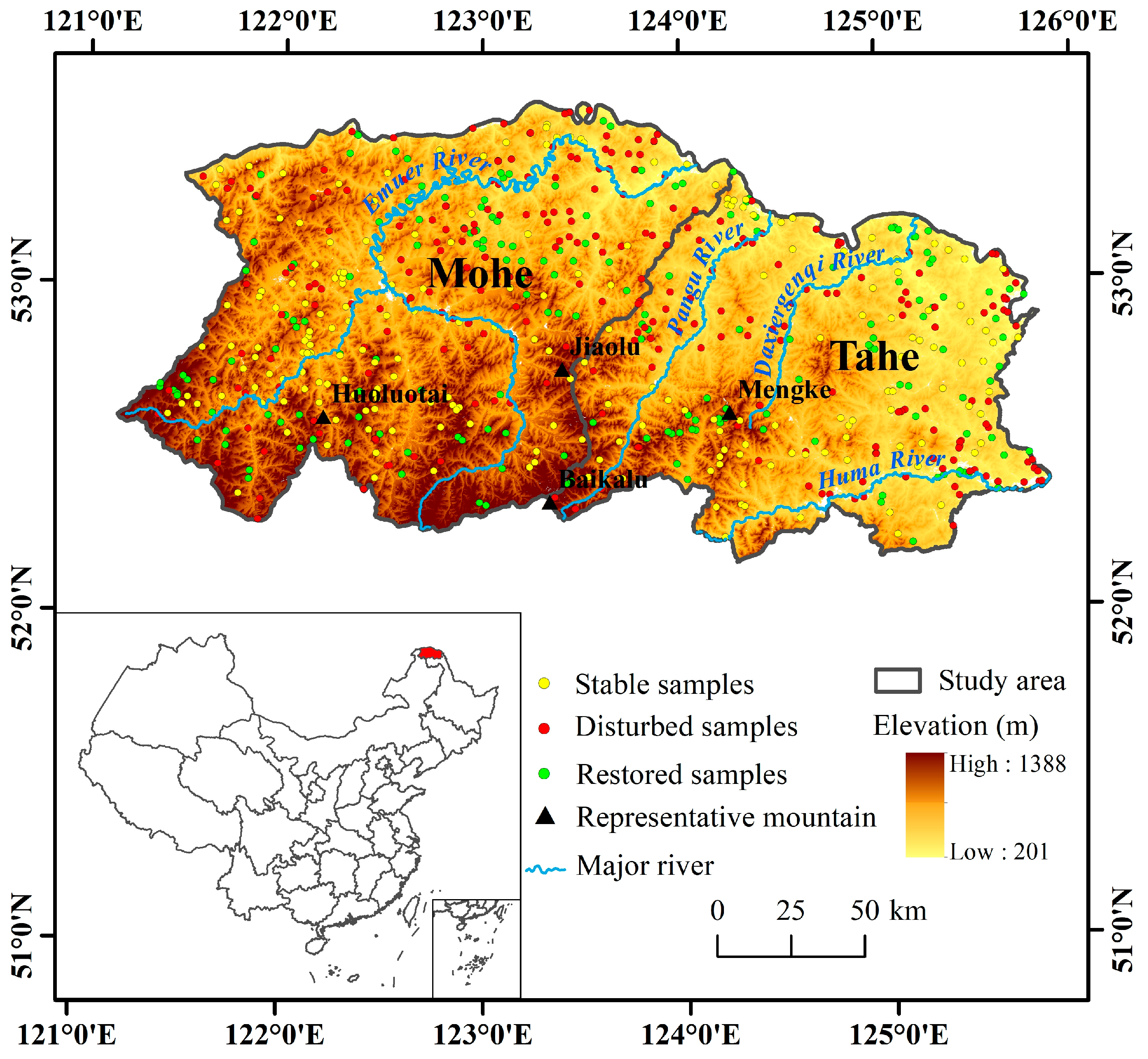
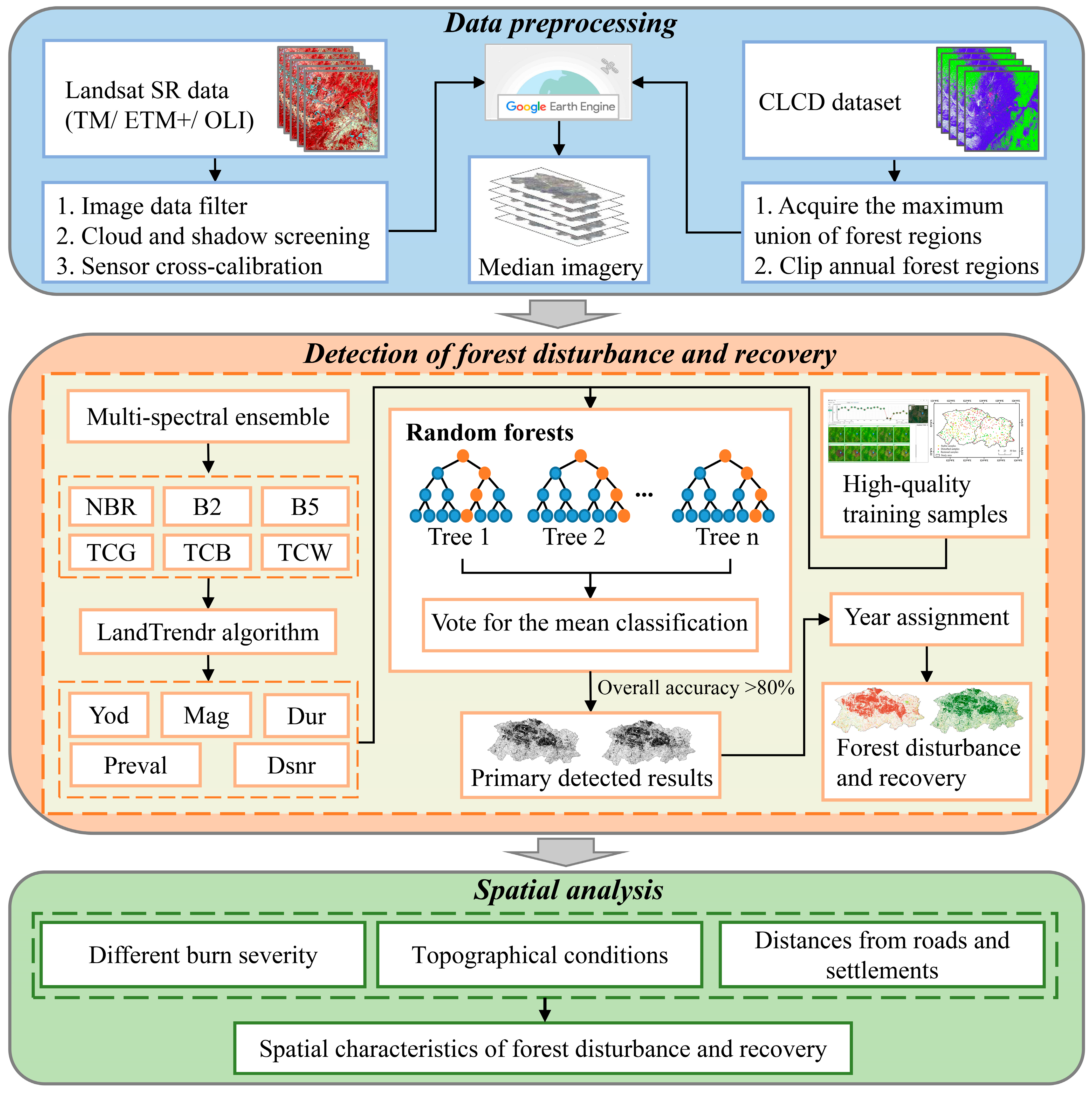
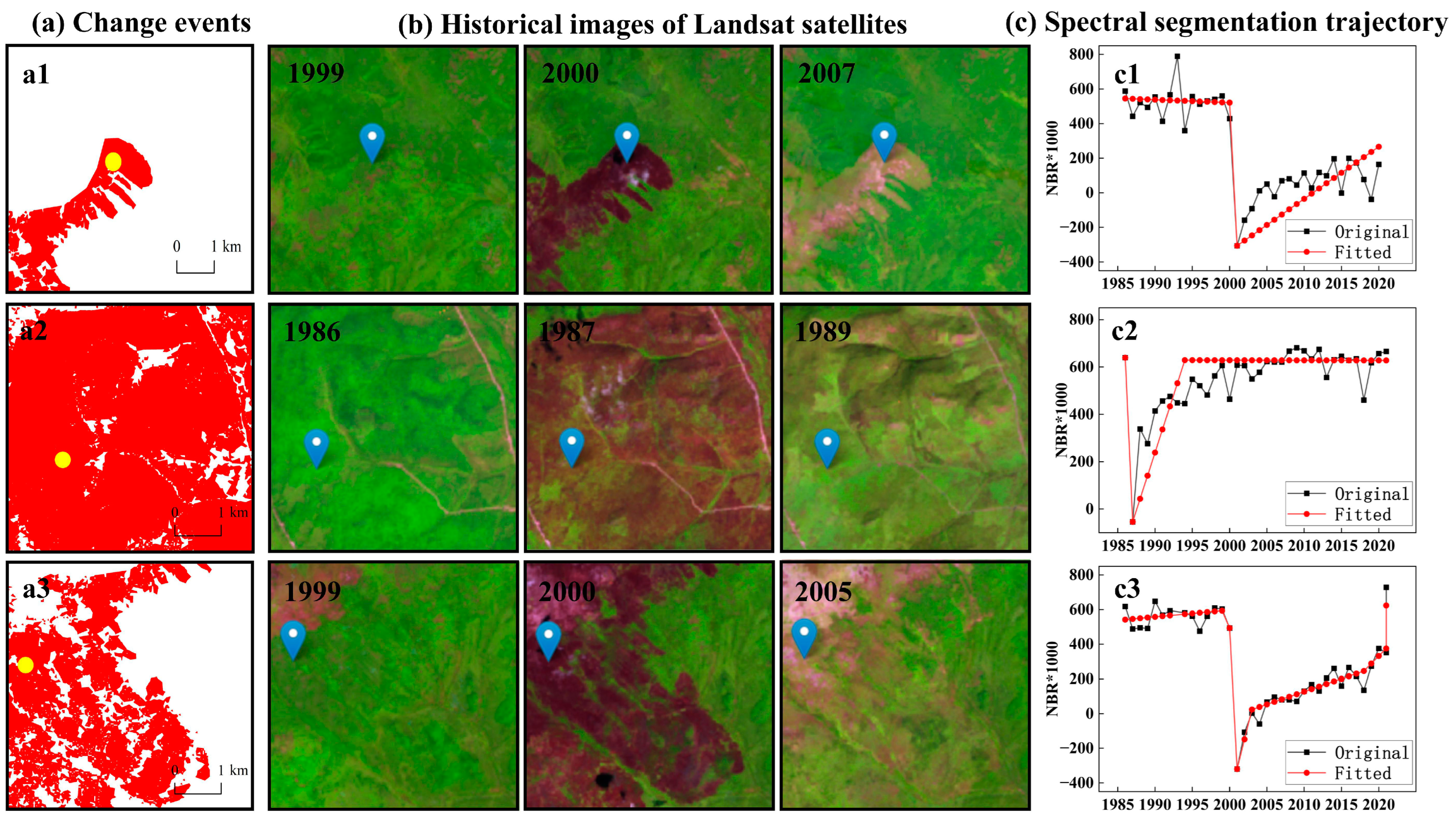
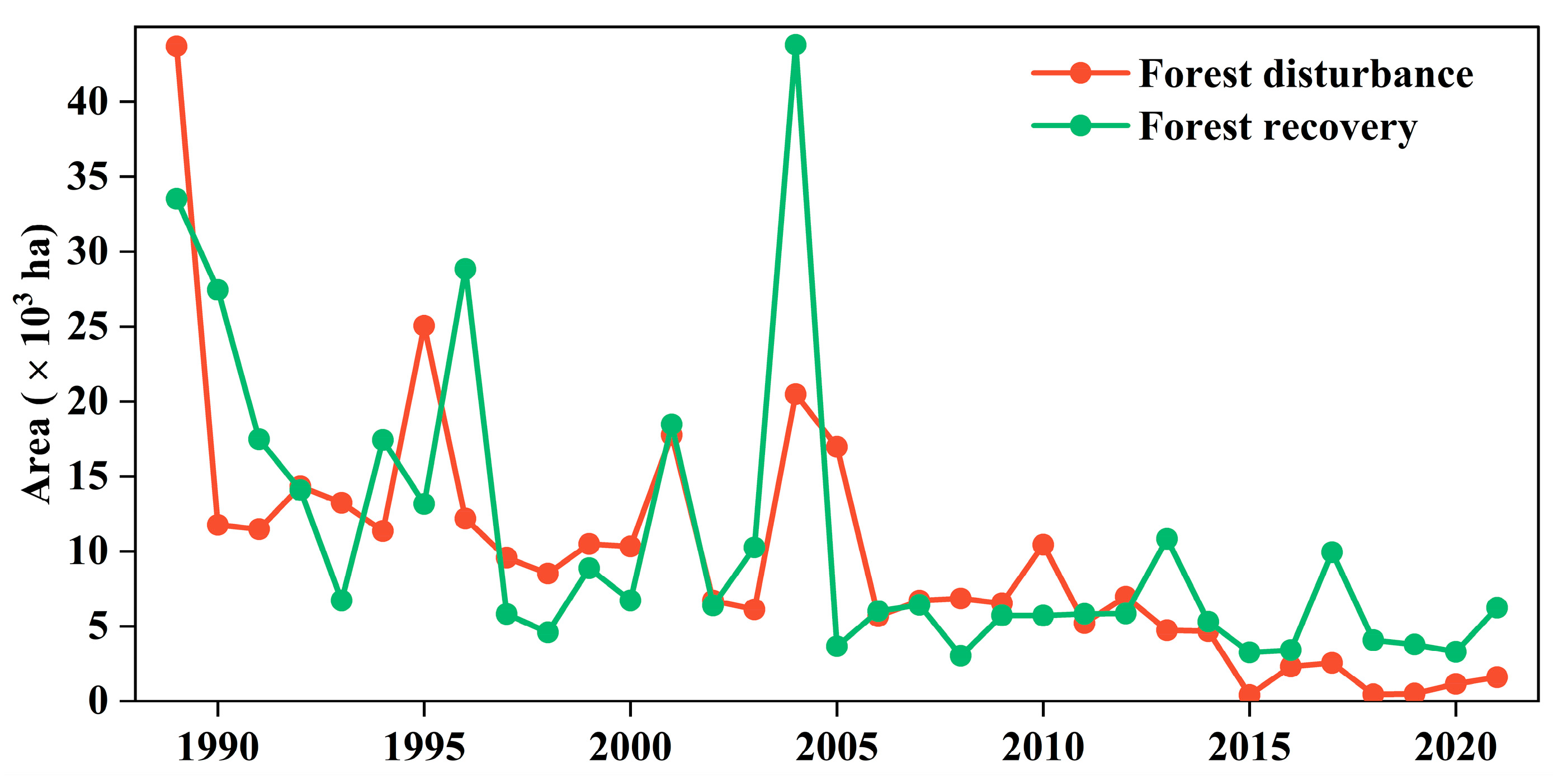
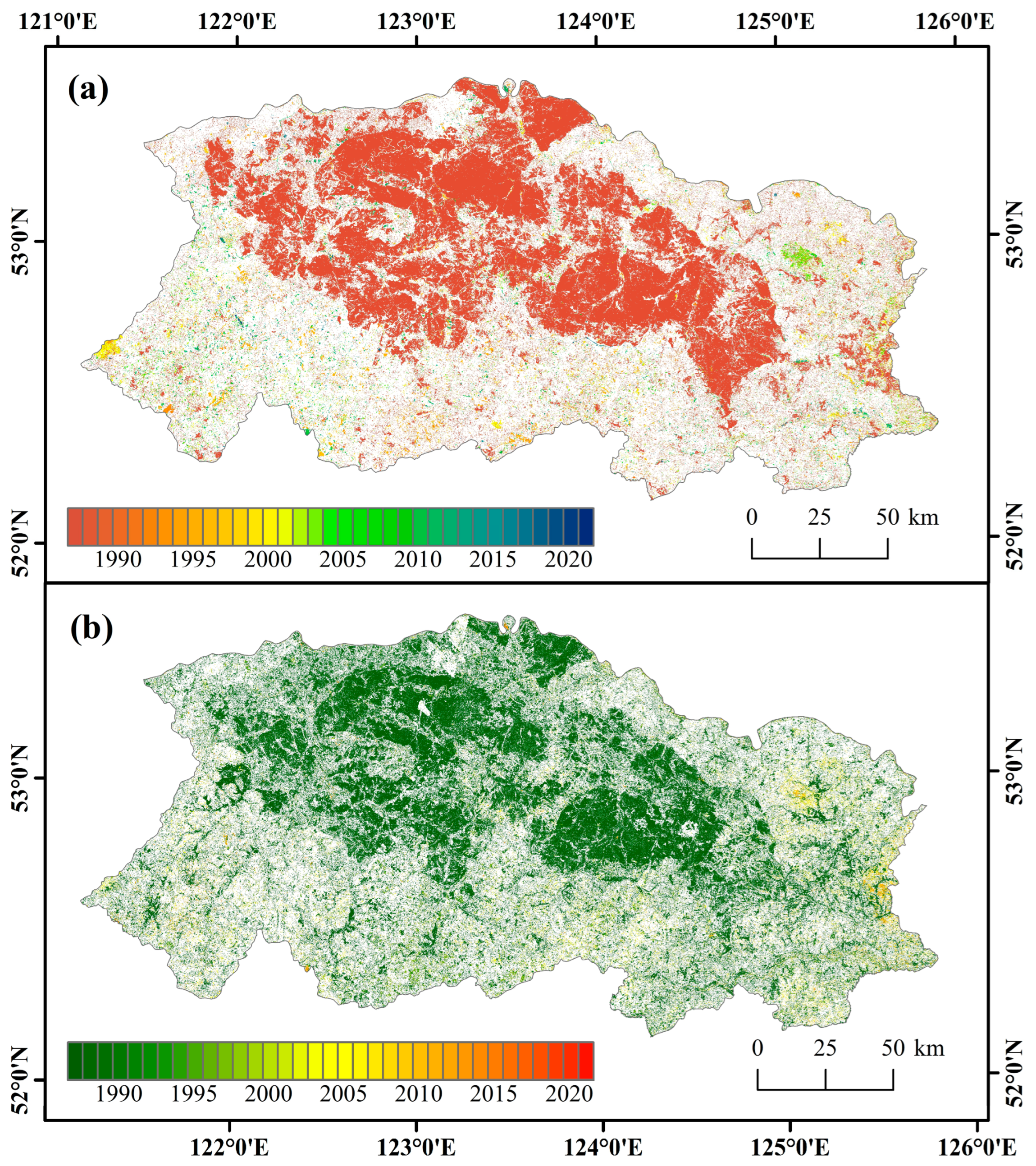
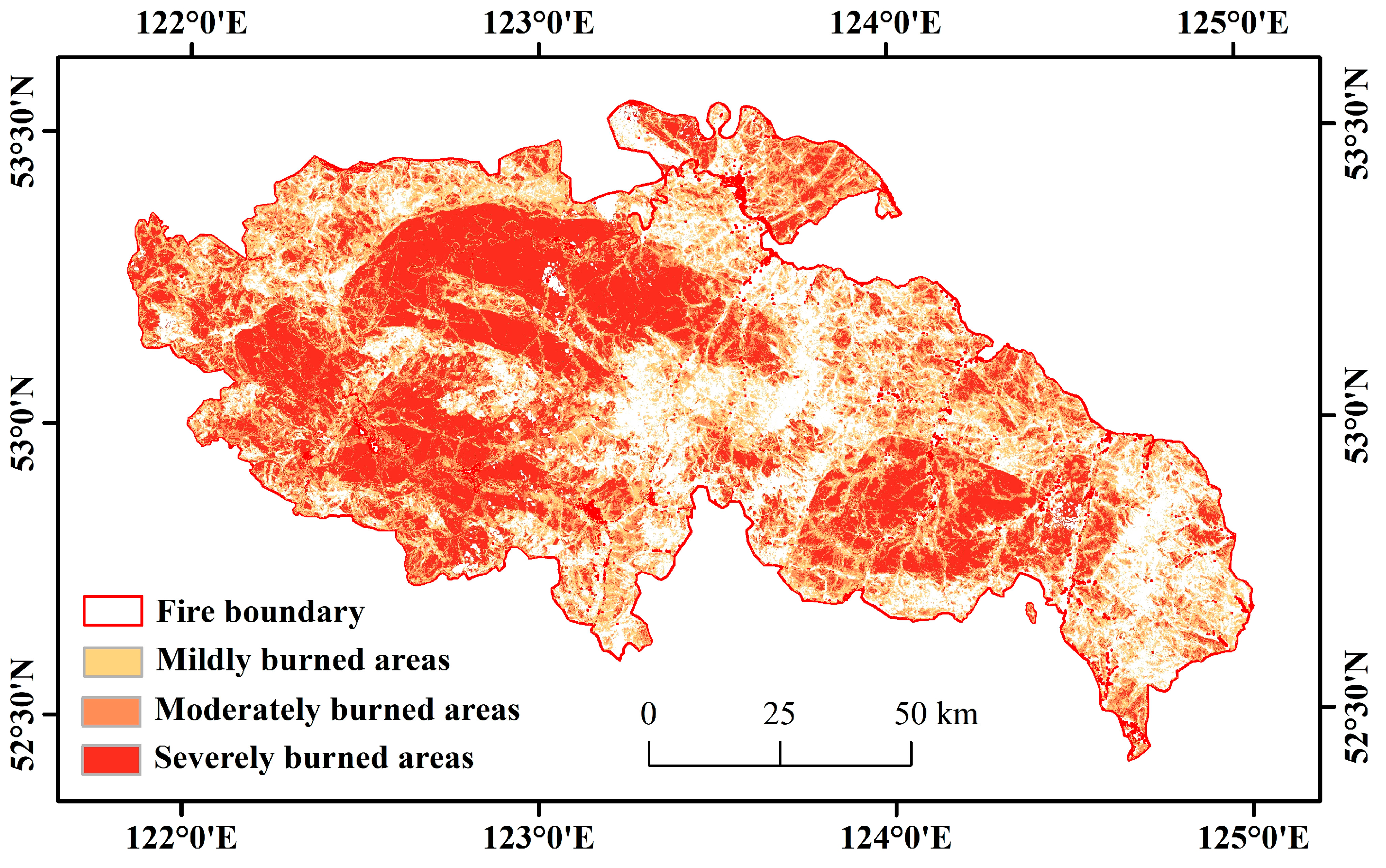
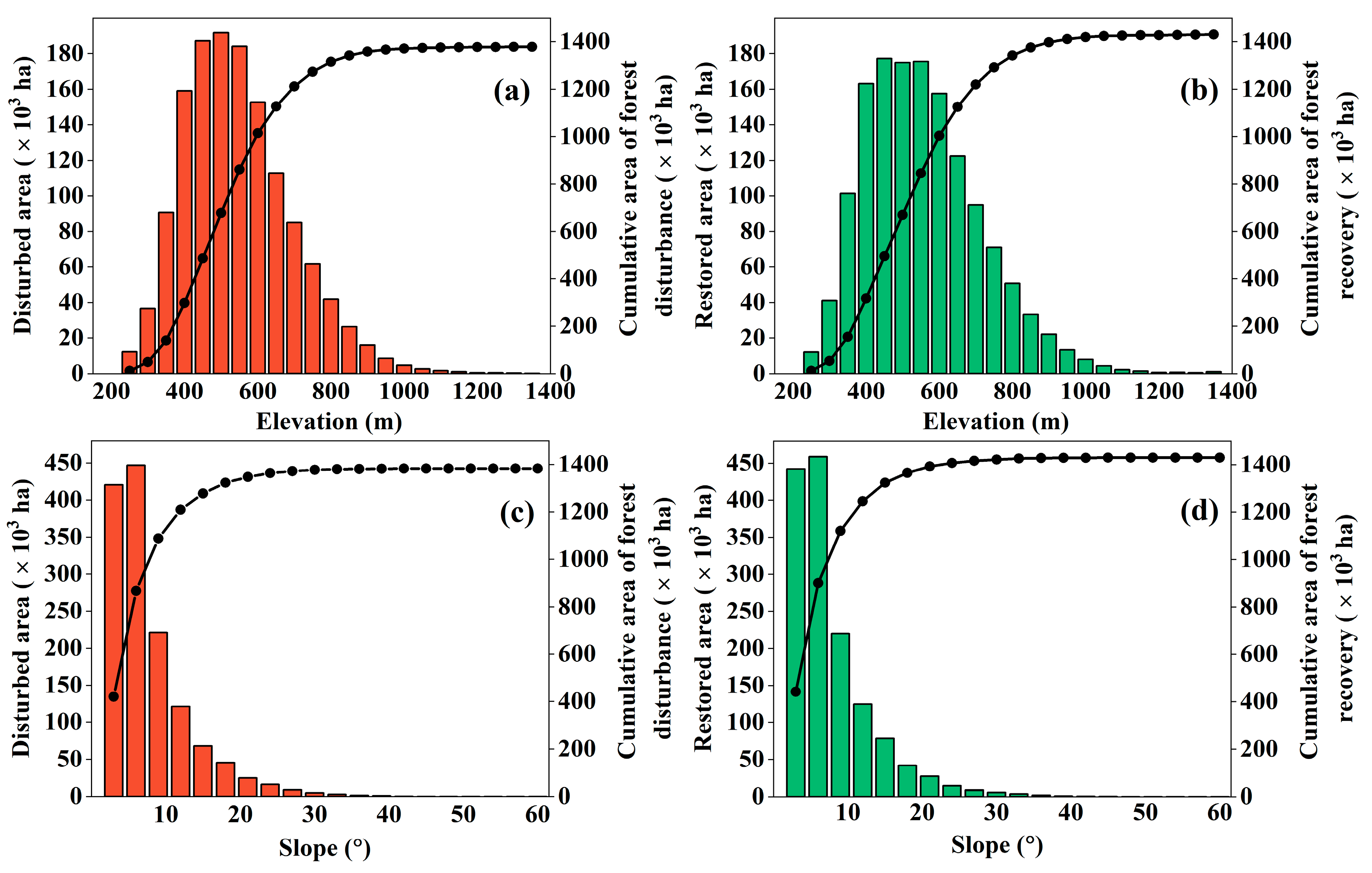
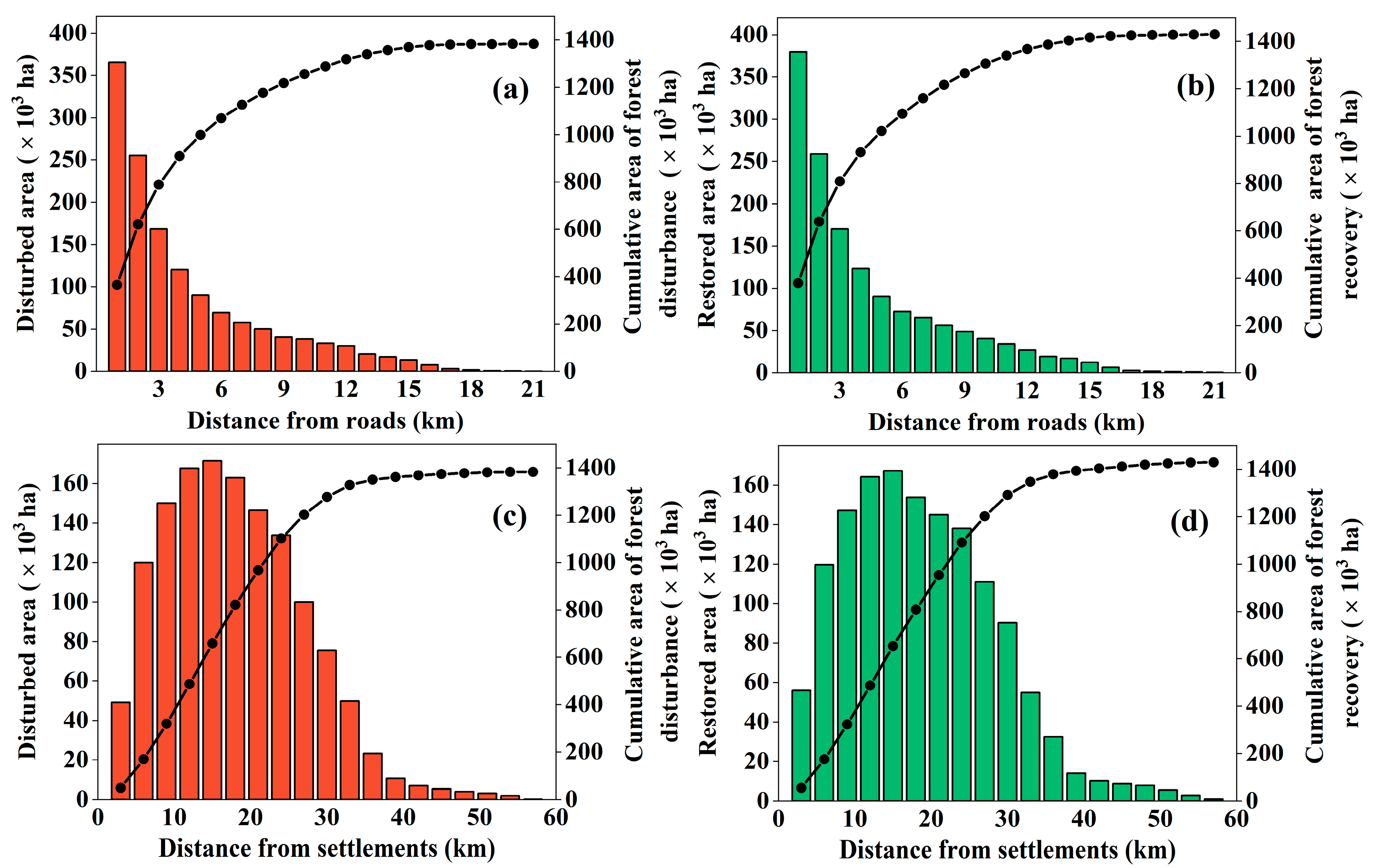
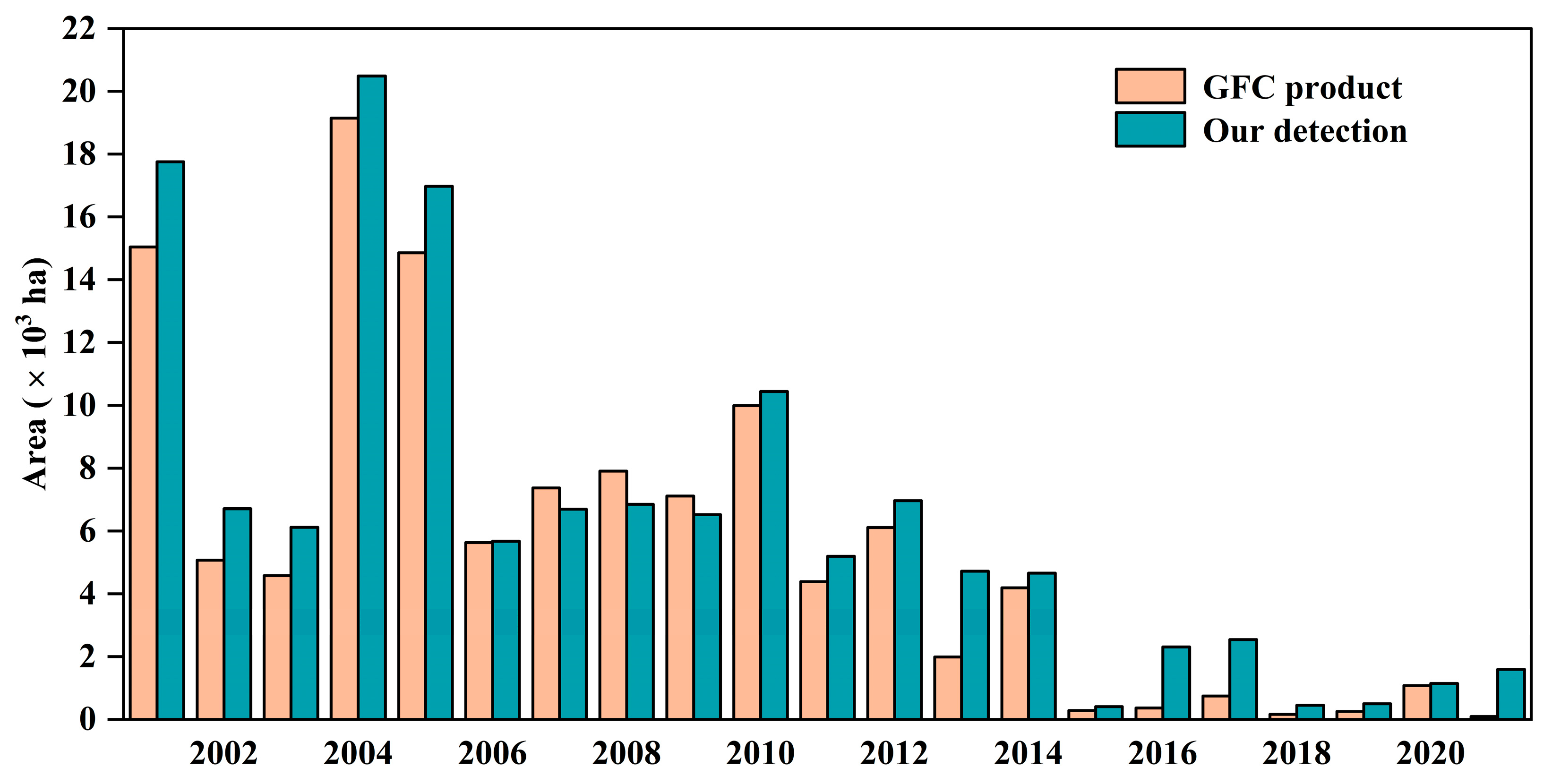
| Data Name | Spatial Resolution | Time Range | Data Source |
|---|---|---|---|
| Landsat imagery | 30 m | 1986–2021 | http://landsat.usgs.gov/ (accessed on 1 September 2022) |
| Annual China Land Cover Dataset (CLCD) | 30 m | 1985 and 2021 | https://doi.org/10.5281/zenodo.5816591 (accessed on 1 June 2022) |
| National Forest Inventory (NFI) data | - | 2016–2021 | The Forest Bureau of the Heilongjiang province |
| Hansen Global Forest Change v1.10 (HGFC) | 30 m | 2001–2021 | https://glad.earthengine.app/view/global-forest-change (accessed on 1 September 2022) |
| The Shuttle Radar Topography Mission (SRTM) 1-arcsecond global digital elevation model (DEM) | 30 m | - | http://www2.jpl.nasa.gov/srtm (accessed on 1 June 2022) |
| OpenStreetMap (OSM) | - | Up to date | Https://www.openstreetmap.org/ (accessed on 1 September 2022) |
| Burn Severity | Threshold |
|---|---|
| Unburned areas | ≤0.23 |
| Mildly burned areas | 0.23–0.52 |
| Moderately burned areas | 0.60–0.72 |
| Severely burned areas | ≥0.72 |
| Temporal Window | Forest Disturbance | Forest Recovery | ||||
|---|---|---|---|---|---|---|
| Overall Accuracy | Commission | Omission | Overall Accuracy | Commission | Omission | |
| 1986–1992 | 83.33 | 20.00 | 11.11 | 82.60 | 23.07 | 9.09 |
| 1992–1998 | 88.24 | 12.50 | 12.50 | 84.62 | 21.42 | 8.33 |
| 1998–2004 | 85.71 | 16.67 | 9.09 | 84.00 | 20.00 | 7.69 |
| 2004–2010 | 89.66 | 12.50 | 6.67 | 89.29 | 13.33 | 7.14 |
| 2010–2016 | 88.00 | 14.29 | 7.69 | 85.19 | 20.00 | 20.00 |
| 2016–2021 | 91.67 | 5.26 | 10.00 | 86.49 | 10.53 | 15.00 |
| 1986–2021 | 87.04 | 15.18 | 10.38 | 85.57 | 15.86 | 17.86 |
| Burn Severity | Forest Disturbance | Forest Recovery |
|---|---|---|
| Mildly burned areas | 7.33 | 12.27 |
| Moderately burned areas | 3.45 | 10.22 |
| Severely burned areas | 3.60 | 18.40 |
Disclaimer/Publisher’s Note: The statements, opinions and data contained in all publications are solely those of the individual author(s) and contributor(s) and not of MDPI and/or the editor(s). MDPI and/or the editor(s) disclaim responsibility for any injury to people or property resulting from any ideas, methods, instructions or products referred to in the content. |
© 2023 by the authors. Licensee MDPI, Basel, Switzerland. This article is an open access article distributed under the terms and conditions of the Creative Commons Attribution (CC BY) license (https://creativecommons.org/licenses/by/4.0/).
Share and Cite
Ren, H.; Ren, C.; Wang, Z.; Jia, M.; Yu, W.; Liu, P.; Xia, C. Continuous Tracking of Forest Disturbance and Recovery in the Greater Khingan Mountains from Annual Landsat Imagery. Remote Sens. 2023, 15, 5426. https://doi.org/10.3390/rs15225426
Ren H, Ren C, Wang Z, Jia M, Yu W, Liu P, Xia C. Continuous Tracking of Forest Disturbance and Recovery in the Greater Khingan Mountains from Annual Landsat Imagery. Remote Sensing. 2023; 15(22):5426. https://doi.org/10.3390/rs15225426
Chicago/Turabian StyleRen, Huixin, Chunying Ren, Zongming Wang, Mingming Jia, Wensen Yu, Pan Liu, and Chenzhen Xia. 2023. "Continuous Tracking of Forest Disturbance and Recovery in the Greater Khingan Mountains from Annual Landsat Imagery" Remote Sensing 15, no. 22: 5426. https://doi.org/10.3390/rs15225426
APA StyleRen, H., Ren, C., Wang, Z., Jia, M., Yu, W., Liu, P., & Xia, C. (2023). Continuous Tracking of Forest Disturbance and Recovery in the Greater Khingan Mountains from Annual Landsat Imagery. Remote Sensing, 15(22), 5426. https://doi.org/10.3390/rs15225426










